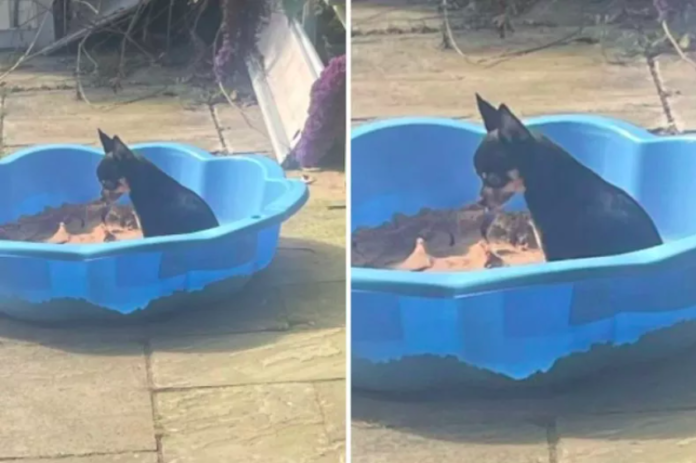Last Updated on July 4, 2024 by Fumipets
Lonely Dog Sitting in Sandpit Melts Hearts as He Yearns for Playmates
Overcoming Reactivity in Dogs: Tips to Help Your Pup Make Friends Again
In a recent heartbreaking TikTok video, a dog named Dwight has captured the hearts of millions. The Chihuahua-Jack Russell terrier mix is seen sitting alone in a sandpit, a stark contrast to the playful canine he once was. Dwight’s owner shared the video, revealing that he has become reactive around other dogs following incidents where he was attacked.
From Friendly Pup to Fearful Canine: Understanding Dog Reactivity
Dog reactivity can be a complex issue with various triggers, including fear, frustration, or excitement. When a dog experiences negative encounters with other dogs, it can develop a sense of fear or anxiety around them. This can manifest in barking, lunging, or growling when approached by another canine.
Dwight’s Story: A Journey of Healing
Dwight’s owner assures viewers that he was once a friendly and social dog who loved playing with other pups. However, after being attacked, his confidence was shattered, leading to his current reactive behavior. The video shows Dwight in his sandpit, seemingly lost in thought, while other dogs play in the distance. This heartbreaking scene highlights the emotional toll that reactivity can take on dogs.
Helping Reactive Dogs Find Their Playful Spirit Again
The good news is that there is hope for reactive dogs like Dwight. With patience, positive reinforcement training, and desensitization techniques, dogs can learn to overcome their fear and interact positively with other canines. Here are some key strategies to consider:
- Avoid Triggering Situations: If your dog is reactive around other dogs, it’s important to avoid situations that might trigger their response. This could involve steering clear of busy dog parks or opting for walks during quieter times.
- Positive Reinforcement Training: Positive reinforcement training is a reward-based approach that can help dogs associate positive experiences with other dogs. This can involve rewarding calm behavior around other canines or using treats to gradually introduce your dog to positive interactions with other dogs at a safe distance.
- Desensitization and Counterconditioning: Desensitization involves gradually exposing your dog to their trigger in a controlled setting. Counterconditioning involves pairing the trigger with a positive experience, such as a treat or praise. Over time, this can help your dog develop a more positive association with other dogs.
- Understanding Dog Body Language: Learning to read your dog’s body language is crucial in managing reactivity. Signs of anxiety or fear in dogs can include yawning, lip licking, whale eye (showing the whites of the eyes), or a tucked tail. By recognizing these signs early on, you can intervene before your dog reacts negatively.
Dwight’s Road to Recovery
Dwight’s owner is committed to helping him overcome his reactivity. They have reported positive progress, with Dwight exhibiting calmer behavior and improved focus when encountering other dogs. While there will be good and bad days, Dwight’s story serves as an inspiration for dog owners facing similar challenges.
FAQs: Reactive Dogs
What are the signs of a reactive dog?
Common signs of reactivity in dogs include barking, lunging, growling, whining, or cowering when approached by other dogs.
What causes dog reactivity?
Dog reactivity can be caused by various factors, including negative experiences with other dogs, fear of the unknown, frustration, or underlying medical conditions.
How can I help my reactive dog?
There are several ways to help your reactive dog, including positive reinforcement training, desensitization, counterconditioning, and avoiding trigger situations. Consulting with a certified professional dog trainer can be extremely beneficial in creating a personalized training plan for your dog.
Can a reactive dog ever become friendly with other dogs?
With patience, consistent training, and the help of a professional, many reactive dogs can learn to overcome their fear and interact positively with other canines.
Where can I find resources for helping my reactive dog?
The American Kennel Club (AKC) and the American Society for the Prevention of Cruelty to Animals (ASPCA) are valuable resources for dog owners seeking information and guidance on managing dog reactivity.
Remember, Dwight’s story is a reminder that with love, patience, and proper training, even reactive dogs can find their way back to enjoying positive social interactions with other furry friends.
Source: [Owner Sheds Tear Over Reactive Dog Playing Alone as He Has ‘No Friends’](https://www.newsweek.com/owner-sheds-tear-over-reactive-dog-playing-alone-


















